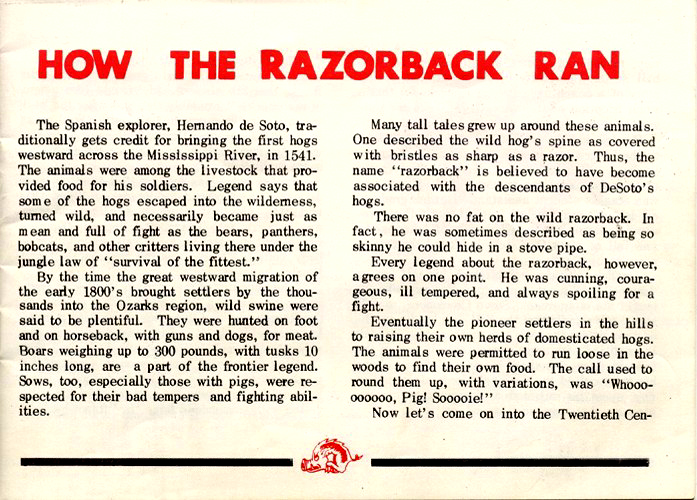History of Arkansas Razorbacks

Text
The Spanish explorer, Hernando de Soto, traditionally gets credit for bringing the first hogs westward across the Mississippi River, in 1541. The animals were among the livestock that provided food for his soldiers. Legend says that some of the hogs escaped into the wilderness, turned wild, and necessarily became just as mean and full of fight as the bears, panthers, bobcats, and other critters living there under the jungle law of "survival of the fittest."
By the time the great westward migration of the early 1800's brought settlers by the thousands into the Ozarks region, wild swine were said to be plentiful. They were hunted on foot and on horseback, with guns and dogs, for meat. Boars weighing up to 300 pounds, with tusks 10 inches long, are a part of the frontier legend. Sows, too, especially those with pigs, were respected for their bad tempers and fighting abilities.
Many tall tales grew up around these animals. One described the wild hog's spine as covered with bristles as sharp as a razor. Thus, the name "razorback" is believed to have become associated with the descendants of DeSoto's hogs.
There was no fat on the wild razorback. In fact, he was sometimes described as being so skinny he could hide in a stove pipe.
Every legend about the razorback, however, agrees on one point. He was cunning, courageous, ill tempered, and always spoiling for a fight.
Eventually the pioneer settlers in the hills [took] to raising their own herds of domesticated hogs. The animals were permitted to run loose in the woods to find their own food. The call used to round them up, with variations, was "Whooooooooo, Pig! Sooooie!"
Now let's come on into the Twentieth Cen-

